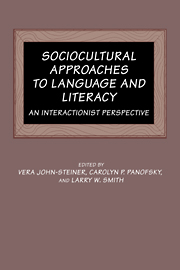Part II - Mediational processes
Published online by Cambridge University Press: 05 November 2011
Summary
A central concept in an interactional understanding of human thinking is “mediation.” In his book-length treatment of Vygotsky's ideas, Wertsch (1985) argues that “Vygotsky made his most important and unique contribution with the concept of mediation” (p. 15). This was Vygotsky's view also; Wertsch quotes Vygotsky as stating “the central fact about our psychology is the fact of mediation” (ibid.). The six chapters in this section share a concern with mediation. Here we clarify the conceptual outlines of mediation that are assumed but not necessarily explicit in the chapters that follow.
“Mediation” refers to the tools, signs, and practices that contribute to qualitative changes in development. Jerome Bruner, in his introduction (1962) to the first translation of Vygotsky's work, points to the central quality of mastery in mediation: Vygotsky
believed that in mastering nature we master ourselves. For it is the internalization of overt action that makes thought, and particularly the internalization of external dialogue that brings the powerful tool of language to bear on the stream of thought. Man, if you will, is shaped by the tools and instruments that he comes to use, and neither the mind nor the hand alone can amount to much. … And if neither hand nor intellect alone prevails, the tools and aids that do are the developing streams of internalized language and conceptual thought that sometimes run parallel and sometimes merge, each affecting the other.
(Bruner, 1962, p. vii)- Type
- Chapter
- Information
- Sociocultural Approaches to Language and LiteracyAn Interactionist Perspective, pp. 139 - 146Publisher: Cambridge University PressPrint publication year: 1994



